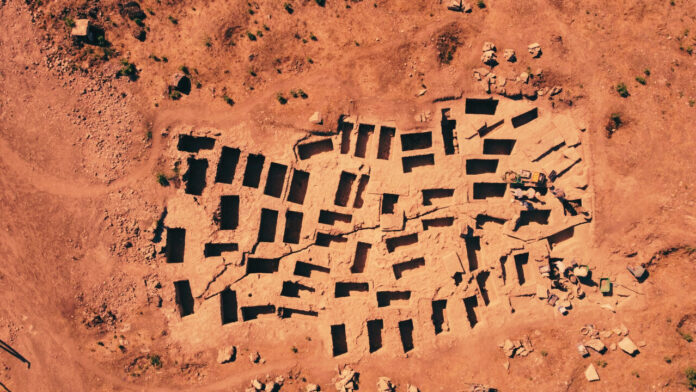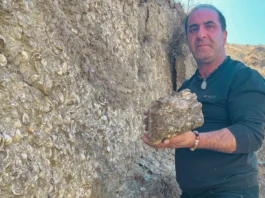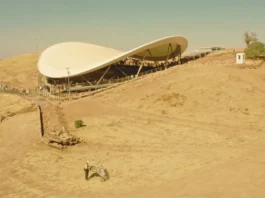A Forgotten City Reveals Its Secrets
In a remarkable archaeological breakthrough, researchers have unearthed 60 rock-carved tombs in Colossae Ancient City, located near Honaz in Denizli Province, western Turkey.
These graves, carved side by side into natural travertine rock and containing skeletal remains and funerary artifacts, date back approximately 2,200 years — opening a new window into one of Anatolia’s least-explored ancient cities.
The site, situated at the foothills of Mount Honaz along the Aksu Stream, has roots stretching as far back as the Chalcolithic Age (5000–3000 BC). Excavations are being led by Dr. Barış Yener of Pamukkale University, under the supervision of the Turkish Ministry of Culture and Tourism, as part of the Legacy for the Future Project.
From a Thriving Trade Center to Lost Ruins
Founded in the 6th century BC, Colossae once stood as an important textile and wool-producing hub on major trade routes of Phrygia.
It thrived under Persian rule, later becoming a spiritual center during the Roman and Byzantine eras.
Early Christian texts even mention Colossae as one of the key cities of the region, alongside Laodicea and Hierapolis.
However, the city gradually declined after its neighbors rose to prominence. A powerful earthquake in the 1st century AD caused severe damage.
Although it was later rebuilt under the name Chonae between 692 and 787 AD, the site was completely abandoned after another major quake.
After three years of intensive surface research, 2025 marked the first official excavation campaign ever launched in Colossae — and the discoveries have already exceeded expectations.
Sixty Rock-Cut Tombs: A Necropolis of Stone
Dr. Yener and his team have revealed a large necropolis zone, with 60 rock-cut “trough” tombs carved neatly into travertine cliffs.
Each measures about 1.8 m long, 1 m wide, and up to 1.5 m deep, forming one of the largest rock-carved burial clusters in Anatolia.
“Ancient inhabitants used rocky terrain wisely,” explains Dr. Yener.
“Since fertile land was crucial for agriculture, they reserved the travertine slopes for graves. These tombs were positioned side by side to conserve space — a reflection of both practicality and sacred planning.”
Archaeologists have excavated 60 of the 65 identified graves, uncovering skeletal fragments, personal belongings, and objects placed as offerings for the afterlife.
Magic, Faith, and Everyday Life in the Afterworld
Beyond the structural marvels, what truly fascinates scientists are the objects of faith and protection found inside the tombs.
The discoveries include amulets, talismans, and stones once believed to hold magical or healing powers, along with terracotta vessels, glass bottles, oil lamps, coins, and even sandals.
“These findings show how the people of Colossae placed great trust in spiritual and magical protection,” says Dr. Yener.
“They tried to safeguard their souls through symbols and rituals — blending daily religious practices with funerary traditions.”
Such artifacts reveal that death was not merely an ending, but a continuation of spiritual life, echoing the region’s diverse mix of Anatolian, Hellenistic, and early Christian influences.
A Protected Site Under Modern Supervision
The excavation area — roughly 20 acres — is now fully fenced and monitored with security cameras, ensuring both scientific safety and cultural preservation.
The project aligns with the Turkish Ministry of Culture’s long-term strategy to protect archaeological heritage while encouraging sustainable tourism.
According to the excavation team, the Colossae necropolis may provide the missing link between Late Chalcolithic communities and early medieval Anatolia, offering a continuous historical timeline from prehistoric ages to the Turkification of Honaz in 1206 AD.
Why the Colossae Discovery Matters
This groundbreaking find is significant for several reasons:
- Historical continuity: Colossae bridges more than five millennia of Anatolian civilization.
- Cultural insight: The magical artifacts highlight deep spiritual and psychological dimensions of ancient life.
- Architectural innovation: The clustered, space-efficient design of tombs reflects sophisticated planning.
- Tourism potential: Situated close to Pamukkale, Hierapolis, and Laodicea, Colossae could become Turkey’s next major archaeological and faith-tourism destination.
Looking Ahead: The Next Chapter of Excavation
Future excavation stages will target Colossae’s urban core, including residential zones, temples, and public structures that could reveal more about the city’s socio-economic fabric.
Researchers hope to find inscriptions or documents that clarify who these buried individuals were — merchants, soldiers, or families tied to the nearby trade routes.
As studies continue, the ancient city promises to reshape what historians know about spiritual life and death in Anatolia during the Hellenistic and Roman periods.
A Legacy Beneath the Earth
The 2,200-year-old tombs of Colossae Ancient City remind us that, long before modern faiths and nations, people sought connection, protection, and remembrance.
Their offerings — from simple oil lamps to enchanted stones — tell a universal story of hope and continuity beyond death.
Thanks to modern archaeology, that story is now being retold, bringing the ancient voices of Colossae back to life after thousands of silent years.



